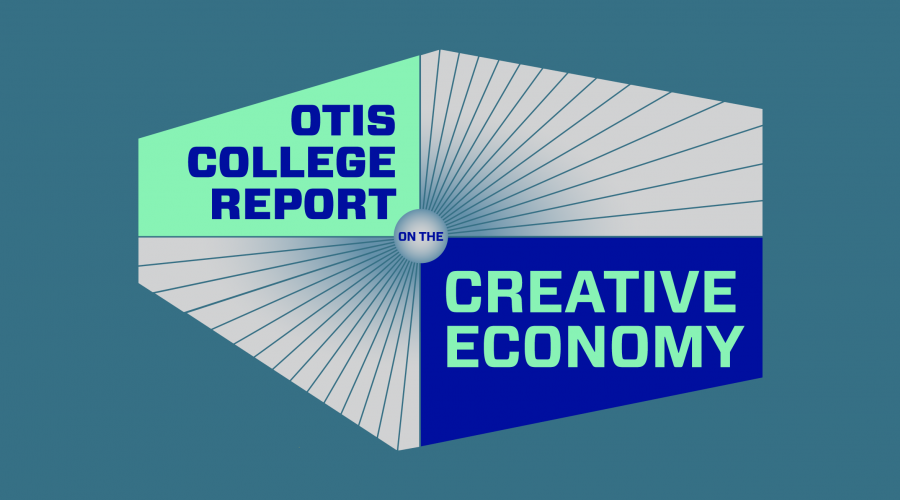
At a virtual event on April 13, Otis College of Art and Design released its findings for the 2022 Otis College Report on the Creative Economy, featuring welcome remarks from Otis College President Charles Hirschhorn and a presentation on this year’s findings, followed by a panel discussion focusing on the digital creative economy. The Report this year included comprehensive data throughout 2020, the first year of the COVID-19 pandemic, measuring in detail the impacts that the pandemic had on the creative industries in California, their recovery since that time, as well as key recommendations to improve conditions to promote the overall growth of the creative economy despite ongoing global and economic challenges.
“The Otis College Report on the Creative Economy makes it clear that the creative economy is essential to the Los Angeles region, and to the state’s overall economy, contributing a total economic impact equivalent to roughly 23% of California’s gross regional product. Its total economic impact makes it one of the largest sectors in the state’s economy. How we develop these sectors and prepare the next generation of creatives has far reaching implications and deserves our critical attention,” says President Hirschhorn.
The 2022 Report was produced in partnership with CVL Economics, an economics research and planning firm committed to rethinking, reframing, and redefining the future of equitable development. The Report details findings and data on the five creative industry sectors of Architecture and Related Services, Creative Goods and Products, Entertainment and Digital Media, Fashion, and Fine and Performing Arts throughout the state of California, including eight regional snapshots. Throughout the Report, Los Angeles County is contrasted with New York City as one of the two largest creative economic centers of the United States.
Following a presentation of key findings, the 2022 release event included a panel discussion on the topic, “The Rise of the Digital Creative Economy,” moderated by Rio Caraeff, Chief Commercial Officer of Syng, and a member of the Otis College Board of Governors. Joining the panel was Chrysta Marie Burton, EVP, Physical Production, Bad Robot; Rachel Moore, President and CEO, The Music Center; Christopher Stringer, CEO and Chief Design Officer, Syng; and Timoni West, Vice President, Augmented & Virtual Reality, Unity Technologies.
The Report, now in its 15th year, has become a benchmark study in the creative economy in California and the impact that creative industries play in the overall economy. The Report is downloaded annually by people from over 35 countries as a model for documenting the creative sectors.
Key findings in the 2022 Otis College Report on the Creative Economy include:
- At nearly $687.6 billion, the creative industries supported economic activity equivalent to roughly 23% of the state’s gross regional product (GRP) of nearly $3 trillion in 2020—making it the one of the largest sectors in the economy—supporting total employment across the state economy of 3.9 million jobs.
- In California, average annual wages in the creative economy more than doubled between 2007 and 2020 (from $75,824 to $158,477) compared to a 53.7% increase (from $49,817 to $76,590) across all sectors. However, the creative economy is far from monolithic. Employment in creative economy industry groups includes both high-earning creatives working in Entertainment and Digital Media ($189,000) and Architecture and Related Services ($101,000), as well as lower-earning creatives working in Fine and Performing Arts ($52,800).
- Of the five industry groups studied, Architecture and Related Services was the most stable sector in the face of the pandemic’s economic disruption. Employment fell by only 2.2% between 2019 and 2020, where industry jobs totaled 226,000.
- Entertainment and Digital Media’s direct employment dipped by 3.3% in 2020, largely due to production disruptions and cinema closures. It remains California’s most robust creative sector and employs nearly one million workers (981,000) statewide, largely concentrated in Los Angeles County and the Bay Area.
The Report also presents recommendations that the state should make to improve conditions for the creative economy to grow at this time, including:
- Increasing the availability of affordable housing and affordable commercial real estate for growing small businesses and for housing workers in the creative fields.
- Adapting the Film and Television tax incentives in California to also include the growing pool of post-production, VFX, animation, and gaming industries.
- Cultivating talent for the creative sectors through better partnership between existing state educational infrastructure with the commercial sector.
The 2022 Otis College Report on the Creative Economy is available to download as a PDF from a dedicated, interactive website, which also allows for greater investigation into the Report findings at otis.edu/creative-economy/2022.
Funding for the 2022 Otis College Report on the Creative Economy has been provided by the California Community Foundation; City National Bank; Department of Cultural Affairs, City of Los Angeles; Gallagher; Getty Foundation; Los Angeles Tourism & Convention Board; Marsh; Mellon Foundation; Moss Adams; Music Man Foundation; Perenchio Foundation; The Ralph M. Parsons Foundation; and Sony Pictures Entertainment.


